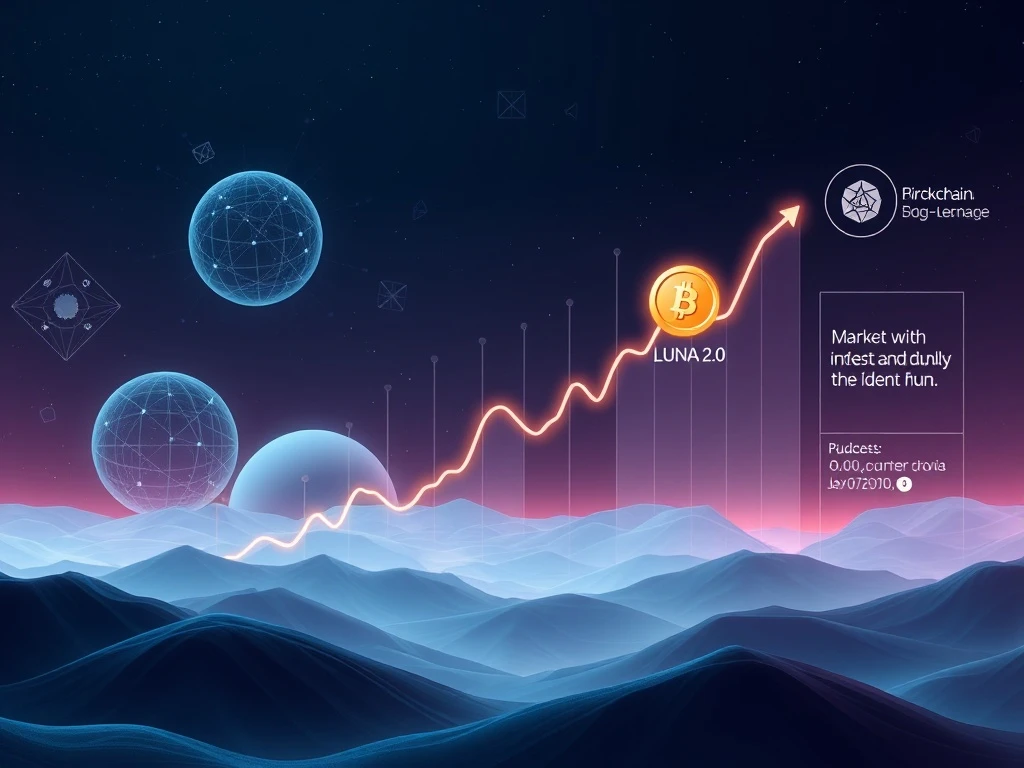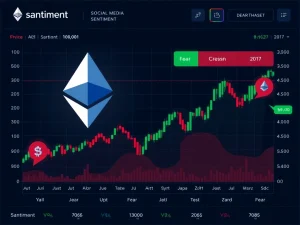Terra LUNA 2.0: Unveiling Ambitious Price Predictions Amidst Rebranding Efforts

The cryptocurrency landscape is a whirlwind of innovation and speculation, where fortunes can be made and lost in the blink of an eye. Among the tokens that consistently capture attention, Terra LUNA 2.0 stands out, not just for its ambitious price forecasts but also for its compelling backstory. After a tumultuous past, this rebranded asset is once again at the center of investor discussions, with some analysts projecting its price could soar to $3.75 by 2030. But what drives such optimism, and what challenges lie ahead for a project still rebuilding its foundation?
Unpacking Terra LUNA 2.0’s Resurgence and Price Predictions
The journey of Terra LUNA 2.0 is unique in the crypto world. Born from the ashes of the original Terra (LUNA) ecosystem’s dramatic collapse in May 2022, this new iteration aimed to preserve the developer community and rebuild investor confidence. Fast forward to mid-2025, and various market analyses are painting a picture of potential growth, albeit with significant caveats. The headline projection suggests that Terra LUNA 2.0 could reach as high as $3.75 by 2030.
These projections are not arbitrary. They are often underpinned by specific assumptions, such as a consistent 5% annualized growth rate from its estimated price in mid-2025. For instance, analysis from Binance in July 2025 suggested the token could reach $1.29 by 2025, predicated on a 5% annualized growth rate from its estimated price of $0.190325 at that time. Other major exchanges like Kraken and MEXC echo similar trends, with Kraken forecasting a gradual increase under the same growth assumption, while MEXC anticipates a broader trajectory for the asset.
It is crucial to understand that these optimistic forecasts explicitly differentiate Terra LUNA 2.0 from its predecessor, Terra Classic (LUNC), which continues to face a more bearish outlook due to its historical baggage and different tokenomics. The optimism surrounding LUNA 2.0 is largely tied to Terra’s rebranded ecosystem, which aims to attract long-term holders through improved tokenomics and staking incentives.
The Optimistic Horizon: What Drives LUNA 2.0 Price Prediction?
Several factors contribute to the bullish sentiment surrounding the LUNA 2.0 price prediction. While past performance is no guarantee of future results, proponents point to key strategic shifts and market dynamics:
- Rebranding and Ecosystem Focus: The new Terra blockchain, post-fork, is designed with a focus on stability and developer activity. It emphasizes community governance and aims to foster a new generation of decentralized applications (dApps) without the algorithmic stablecoin mechanism that led to the original collapse. This rebranding is crucial for shedding the negative perception of the past.
- Improved Tokenomics: LUNA 2.0’s tokenomics are structured differently, aiming for more predictable supply and demand dynamics. Staking incentives play a significant role, encouraging users to lock up their tokens, which can reduce circulating supply and potentially support price appreciation. These incentives are vital for attracting and retaining long-term investors.
- Broader Market Adoption: For LUNA 2.0 to hit higher price targets like $3.75, it would require substantial adoption across the wider cryptocurrency market. This means more users interacting with its dApps, more developers building on its chain, and increased integration with other crypto protocols. Technological advancements, such as enhanced scalability or interoperability, would also be key enablers.
- Community Resilience: Despite the severe setback, a dedicated community remained. This core group’s commitment to rebuilding and supporting the ecosystem provides a foundation for recovery and growth, which is often underestimated in traditional finance but critical in decentralized networks.
Rebuilding Investor Trust: A Core Challenge for Terra
The journey for Terra LUNA 2.0 is not without its significant hurdles. The most formidable challenge remains rebuilding investor trust. The 2022 collapse of UST, Terra’s algorithmic stablecoin, and the subsequent crash of the original LUNA token, sent shockwaves through the entire crypto industry, resulting in billions of dollars in losses. This event left a lasting scar on the perception of the Terra brand.
To address this, Terra’s new leadership and community have focused on transparency and a more decentralized governance model. However, the memory of such a catastrophic event lingers, making many investors wary. While some analysts, such as those at Kraken, acknowledge the project’s foundational strengths, others caution that macroeconomic headwinds could disrupt short-term trajectories. The path to fully restoring confidence is long and requires consistent delivery on promises, robust security measures, and a clear demonstration of sustained utility and stability.
The success of Terra LUNA 2.0 hinges on its ability to prove that its new architecture is resilient and that past vulnerabilities have been adequately addressed. This isn’t just about code; it’s about psychology and market perception.
Navigating Crypto Market Volatility: Risks and Realities
Even with optimistic projections, the inherent crypto market volatility presents substantial risks. Cryptocurrency markets are notoriously unpredictable, influenced by a myriad of factors:
- Macroeconomic Factors: Global interest rates, inflation, and geopolitical events can significantly impact investor sentiment and capital flow into risk assets like cryptocurrencies. A tightening monetary policy, for example, often leads to a decline in crypto prices as investors seek safer havens.
- Regulatory Shifts: Governments worldwide are increasingly scrutinizing the crypto space. New regulations, particularly those concerning stablecoins or decentralized finance (DeFi), could either stifle innovation or provide much-needed clarity, impacting asset prices. Uncertainty around regulation often leads to price fluctuations.
- Market Sentiment: The crypto market is heavily driven by sentiment, news cycles, and social media trends. FUD (Fear, Uncertainty, Doubt) can quickly spread, leading to sell-offs, while positive news can trigger rapid rallies. This makes long-term predictions especially challenging.
- Lack of Historical Data: For a relatively new asset like LUNA 2.0, there is limited historical data to validate long-term assumptions about market behavior or project resilience. Unlike traditional assets with decades of data, crypto projects are still in their infancy, making any long-term forecast inherently speculative. Binance’s 2025–2030 overview for trending crypto coins underscores the sector’s unpredictability, with price ranges spanning widely for unspecified assets by 2026.
The projections for LUNA 2.0, like many others in the space (such as Changelly’s Stellar (XLM) forecast or GODEX.io’s Axie Infinity (AXS) predictions), highlight a broader trend of cautious optimism. However, these broader trends do not directly apply to the specific dynamics and unique challenges faced by LUNA 2.0.
Terra Classic (LUNC) and USTC: A Separate Path
It’s vital to reiterate the distinction between Terra LUNA 2.0 and its predecessors, Terra Classic (LUNC) and Terra Classic USD (USTC). While all originated from the same blockchain, their trajectories post-collapse diverged significantly. LUNC continues to exist as the token of the original chain, often facing more bearish outlooks due to its association with the past failure and a massive circulating supply.
Similarly, Terra Classic USD (USTC), the de-pegged stablecoin, faces an uphill battle. Gate.com’s analysis of USTC notes that even a partial recovery of the token’s functionality as a niche stable-value asset by 2030 would require significant technical and community-driven efforts. LUNA 2.0, on the other hand, represents a new chain and a new beginning, designed to operate independently and avoid the pitfalls of its predecessor’s algorithmic stablecoin model. Its success is not tied to the recovery of USTC or the fortunes of LUNC, but rather on its own merits and ecosystem development.
What Should Investors Consider? Actionable Insights
Given the mix of ambitious forecasts and inherent risks, how should potential investors approach Terra LUNA 2.0?
- Conduct Thorough Due Diligence: Do not rely solely on price predictions. Research the project’s whitepaper, development roadmap, team, and community activity. Understand the technology and its proposed utility.
- Understand the Risks: Acknowledge that crypto investments, especially in projects with a challenging past, carry high risk. Only invest what you can afford to lose.
- Diversify Your Portfolio: Avoid putting all your capital into one asset. Diversification can help mitigate risks across your crypto investments.
- Stay Informed: Keep abreast of macroeconomic trends, regulatory developments, and project-specific news. The crypto landscape evolves rapidly.
Consider the Long Term vs. Short Term: Long-term forecasts like those for 2030 are highly speculative. Short-term price actions and on-chain metrics often diverge from analyst expectations, underscoring the speculative nature of all projections. Be prepared for significant volatility if you’re looking at short-term gains.
Terra’s rebranding and protocol upgrades are clear attempts to address past vulnerabilities. However, sustained growth remains unproven. Current indicators, including short-term price actions and on-chain metrics, often diverge from analyst expectations, underscoring the speculative nature of all projections.
Conclusion: A Path Forward Paved with Potential and Caution
The forecasts for Terra LUNA 2.0 price prediction reaching up to $3.75 by 2030 are undoubtedly exciting, fueled by the promise of rebranding efforts, improved tokenomics, and a dedicated community. The project is actively working to rebuild its ecosystem and attract new users and developers. However, the shadows of its past, coupled with the inherent crypto market volatility and broader macroeconomic uncertainties, mean that such predictions must be approached with a healthy dose of skepticism.
Rebuilding investor trust is a monumental task that requires consistent performance and transparent communication. While LUNA 2.0 aims for a distinct future from Terra Classic (LUNC), its success will ultimately depend on its ability to deliver tangible utility and maintain stability in a highly competitive and unpredictable market. For investors, the journey with Terra LUNA 2.0 is a compelling case study in crypto’s potential for redemption, but one that demands careful consideration and a clear understanding of the risks involved.
Frequently Asked Questions (FAQs)
1. What is Terra LUNA 2.0 and how is it different from Terra Classic (LUNC)?
Terra LUNA 2.0 is the native token of the new Terra blockchain, which was launched in May 2022 after the collapse of the original Terra (LUNC) ecosystem. It is a completely separate chain and token, designed to be independent of the algorithmic stablecoin mechanism (UST) that caused the original collapse. Terra Classic (LUNC) is the token of the original, now defunct, blockchain.
2. What are the key factors driving the optimistic LUNA 2.0 price prediction?
Optimistic forecasts for LUNA 2.0 are primarily driven by its rebranding efforts, which include a focus on a new ecosystem, improved tokenomics (like staking incentives), and a commitment to decentralized governance. Analysts also consider potential broader market adoption and technological advancements on the new chain.
3. What are the main challenges Terra LUNA 2.0 faces in achieving its price targets?
The primary challenge for Terra LUNA 2.0 is rebuilding investor trust after the catastrophic 2022 collapse. Other significant challenges include navigating the inherent crypto market volatility, adapting to macroeconomic factors (like interest rates and inflation), and dealing with evolving regulatory landscapes. The lack of extensive historical data for the new token also makes long-term predictions speculative.
4. Should I invest in Terra LUNA 2.0 based on these forecasts?
Investment decisions should never be based solely on price forecasts, which are inherently speculative. It is crucial to conduct thorough due diligence, understand the significant risks involved, and only invest capital you can afford to lose. Consider your personal financial situation and investment goals before making any decisions.
5. How does the 5% annual growth rate assumption factor into the price predictions?
Many long-term price predictions for LUNA 2.0, including the $3.75 by 2030 forecast, are based on an assumed consistent 5% annualized growth rate from a specific baseline price in mid-2025. This assumption implies steady development, adoption, and favorable market conditions, which may or may not materialize in the volatile crypto market.









